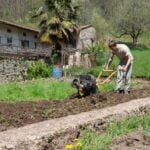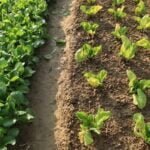Are you wondering how often to water vegetable gardens to ensure healthy growth and bountiful harvests? Proper watering is crucial for the success of any vegetable garden, as it directly affects the plants’ growth, yield, and overall health.
In this article, we will explore the essential factors to consider when determining the frequency of watering your vegetable garden. Understanding the specific water needs of different types of vegetables, signs of overwatering and underwatering, creating a watering schedule, and utilizing efficient watering techniques are just a few of the topics we will cover.
One of the key factors to consider when determining how often to water your vegetable garden is understanding the specific needs of your plants. Different vegetables have varying water requirements based on their size, stage of growth, and environmental conditions. By gaining an understanding of these individual needs, you can tailor your watering schedule to ensure that each type of plant receives the appropriate amount of moisture for optimal growth.
In addition to understanding the water needs of your vegetables, it is important to recognize the signs of overwatering and underwatering in your garden. Overwatering can lead to root rot, mold growth, and nutrient leaching, while underwatering can result in stunted growth, wilting leaves, and decreased crop production. Being able to identify these signs will help you adjust your watering frequency as needed to maintain a healthy balance for your vegetable garden.
Factors to Consider When Determining Watering Frequency
Soil Type and Drainage
One of the most important factors to consider when determining the frequency of watering for your vegetable garden is the type of soil and its drainage. Sandy soils tend to drain more quickly, while clay soils retain water for longer periods. Understanding the soil composition in your garden will help you determine how often you need to water your vegetables.
Weather Conditions
Another essential factor to consider is the weather conditions in your area. Hot and dry climates will require more frequent watering, while cooler and humid climates may necessitate less. Pay attention to rainfall patterns and temperature fluctuations, and adjust your watering schedule accordingly.
Plant Growth Stage
The growth stage of your vegetable plants also plays a significant role in determining watering frequency. Newly planted seeds or seedlings will require more frequent watering to establish their root systems, while mature plants may need less. Be mindful of the specific water needs of each type of vegetable as they grow and develop.
Understanding the Water Needs of Different Types of Vegetables
Different types of vegetables have varying water needs, and it is important for gardeners to understand these requirements in order to effectively maintain the health and productivity of their plants. Leafy greens such as lettuce and spinach typically require more frequent watering due to their shallow root systems and higher water content. On the other hand, root vegetables like carrots and beets prefer less frequent, but deeper watering to encourage their roots to grow downwards.
When considering the water needs of different types of vegetables, it is also important to take into account the climate and soil conditions in which they are grown. In hot and dry climates, plants will require more frequent watering compared to those growing in cooler and more humid environments. Similarly, sandy soils drain water quickly, which may necessitate more frequent watering, while clay soils retain moisture better, requiring less frequent irrigation.
Additionally, fruiting vegetables such as tomatoes, peppers, and cucumbers have specific watering needs at different stages of growth. These plants generally require consistent moisture during flowering and fruit development to prevent issues such as blossom end rot or fruit cracking. Understanding the specific water needs of each type of vegetable will contribute to a healthier garden with higher yields.
Signs of Overwatering and Underwatering in Vegetable Gardens
Proper watering is crucial for the health and success of a vegetable garden. Overwatering and underwatering are common mistakes that can have detrimental effects on the plants. It is important to know the signs of these watering issues so that adjustments can be made to ensure the optimal growth of vegetables.
One of the most common signs of overwatering in a vegetable garden is wilting. This may seem contradictory, as wilting is usually associated with dry soil, but overwatered plants can also wilt due to root damage. Yellowing leaves, slow growth, and mold growth on the soil surface are also indicators of overwatering.
On the other hand, underwatered plants may have dry, crispy leaves and exhibit stunted growth. The soil may also pull away from the edges of the container or garden bed.
To prevent overwatering and underwatering, it’s essential to monitor the moisture level of the soil regularly. Using your finger to check if the top inch of soil is dry before watering can help prevent overwatering. Additionally, using mulch in garden beds can help retain moisture and reduce the likelihood of underwatering. By paying close attention to these signs and making adjustments accordingly, you can ensure that your vegetable garden thrives.
| Common Signs | How to Avoid |
|---|---|
| Wilting, yellowing leaves | Monitor soil moisture regularly; use mulch in garden beds |
| Dry, crispy leaves; stunted growth | Check soil moisture before watering; adjust watering frequency |
The Best Time of Day to Water Vegetable Gardens
When it comes to watering your vegetable garden, the timing is just as important as the frequency. The best time of day to water your vegetable garden is in the early morning. This allows the plants to absorb the moisture they need before the heat of the day kicks in. Watering in the morning also helps to prevent evaporation, ensuring that the water reaches the roots where it’s needed most.
Benefits of Morning Watering
Watering in the morning also helps to prevent fungal diseases that thrive in damp, cool conditions. By allowing the foliage of your vegetables to dry out during the day, you can reduce the risk of diseases such as powdery mildew and blight. Additionally, watering in the morning gives your plants a hydration boost before they start photosynthesizing and producing energy from sunlight.
Risks of Watering in the Evening
Conversely, watering your vegetable garden in the evening can actually be detrimental to your plants. While it may seem convenient to water at this time, it can lead to prolonged periods of moisture on plant leaves and soil, providing an ideal environment for disease-causing pathogens. Additionally, watering in the evening can result in overnight saturation of your garden soil, potentially leading to root rot and other issues.
Tips for Efficient Watering Techniques in Vegetable Gardens
Proper watering is essential for the success of a vegetable garden. By efficiently watering your vegetable garden, you can ensure that your plants are healthy and productive.
Here are some tips for efficient watering techniques in vegetable gardens:
- Mulching: Applying mulch around the base of your plants can help retain moisture in the soil and reduce the frequency of watering. Organic materials such as straw, wood chips, or grass clippings make excellent mulch for vegetable gardens.
- Drip Irrigation: Consider installing a drip irrigation system in your vegetable garden. This method delivers water directly to the base of each plant, minimizing water waste through evaporation or runoff.
- Watering at the Base: When hand-watering your vegetable garden, aim to water at the base of the plants rather than over their foliage. This helps prevent disease and ensures that the roots receive sufficient moisture.
- Deep Watering: Instead of frequent shallow watering, encourage deep root growth by watering less often but more deeply. This allows the roots to access water from lower levels of the soil, making them more resilient during dry periods.
By implementing these efficient watering techniques, you can promote healthy growth and bountiful harvests in your vegetable garden. Remember to monitor soil moisture regularly and adjust your watering schedule based on weather conditions and plant needs.
Creating a Watering Schedule for Vegetable Gardens
When it comes to vegetable gardens, having a consistent watering schedule is essential for the health and growth of the plants. Without a proper watering routine, vegetables can wilt, become stunted in growth, or even fail to produce a good yield. Creating a watering schedule not only ensures that your plants are getting enough moisture but also helps to conserve water and prevent overwatering.
To create an effective watering schedule for your vegetable garden, consider the following factors:
- Types of vegetables: Different types of vegetables have varying water needs. Leafy greens like lettuce and spinach require more frequent watering compared to root vegetables like carrots and beets.
- Soil type: The type of soil in your garden will impact how often you need to water. Sandy soil drains quickly and may require more frequent watering, while clay soil retains moisture longer.
- Weather conditions: Take into account the climate in your area when creating a watering schedule. During hot, dry periods, you may need to increase the frequency of watering.
Once you have considered these factors, you can create a personalized watering schedule for your vegetable garden. This could include specific days of the week or times of day when you plan to water each area of the garden based on its unique needs. Implementing a consistent schedule will help ensure that your vegetables receive the right amount of moisture for optimal growth and production.
Using Tools and Technology to Monitor Soil Moisture in Vegetable Gardens
Properly monitoring soil moisture is essential in maintaining a healthy vegetable garden. Using tools and technology to monitor soil moisture can help ensure that your plants are getting the right amount of water and prevent issues such as overwatering or underwatering. One useful tool for monitoring soil moisture is a soil moisture meter, which measures the level of moisture in the soil and indicates whether it is too dry or too wet.
Another technology that can be used to monitor soil moisture in vegetable gardens is a drip irrigation system. These systems provide a controlled and efficient way of delivering water directly to the roots of plants, ensuring that they receive just the right amount of water. Some drip irrigation systems even come with sensors that measure soil moisture levels and automatically adjust watering accordingly.
In addition to these tools and technology, there are also smartphone apps available that can help you monitor soil moisture in your vegetable garden. These apps often provide real-time data on soil moisture levels, allowing you to make informed decisions about when and how much to water your plants. By utilizing these tools and technology, you can effectively monitor and manage the soil moisture in your vegetable garden, promoting healthy plant growth and maximizing yield.
| Tools and Technology | Benefits |
|---|---|
| Soil Moisture Meter | Measures level of moisture in the soil |
| Drip Irrigation System | Delivers water directly to plant roots; some systems have sensors for automatic adjustment. |
| Smartphone Apps | Provide real-time data on soil moisture levels for informed decision making. |
Common Mistakes to Avoid When Watering Vegetable Gardens
In conclusion, proper watering is essential for the health and productivity of vegetable gardens. Understanding the factors that influence watering frequency, such as soil type, weather conditions, and plant needs, is crucial for successful gardening. It’s important to pay attention to signs of overwatering or underwatering in order to make adjustments to the watering schedule. By following efficient watering techniques and creating a watering schedule, gardeners can ensure that their vegetable plants receive the right amount of moisture.
One common mistake to avoid when watering vegetable gardens is using a one-size-fits-all approach. Different types of vegetables have different water needs, so it’s important to understand the specific requirements of each plant in your garden. Overwatering can lead to root rot and other diseases, while underwatering can cause stunted growth and reduced yields.
Another mistake is not paying attention to soil moisture levels. Using tools and technology to monitor soil moisture can provide valuable information about when and how much to water your vegetable garden. By understanding the moisture levels in the soil, gardeners can make more informed decisions about their watering practices.
Overall, by avoiding common mistakes and following best practices for watering vegetable gardens, gardeners can promote healthy growth and bountiful harvests. With careful attention to the individual needs of each plant and utilizing efficient watering techniques, you can enjoy a thriving vegetable garden all season long.
Frequently Asked Questions
Should I Water My Vegetable Garden Every Day?
Watering your vegetable garden every day may not be necessary and could potentially lead to overwatering, which can harm the plants. It’s important to consider the specific water needs of each type of vegetable you are growing, as well as factors such as soil type, weather conditions, and drainage.
In general, it’s better to water deeply but less frequently to encourage deep root growth and ensure the soil doesn’t become waterlogged.
How Long Should I Run My Sprinklers on My Vegetable Garden?
The duration for which you should run your sprinklers on your vegetable garden depends on several factors such as the type of soil, weather conditions, and the water needs of the specific vegetables you are growing. As a general guideline, aim for about 1 inch of water per week including rainfall.
It’s important to monitor the soil moisture level and adjust the sprinkler duration accordingly to prevent both underwatering and overwatering.
Should I Water Garden Every Morning?
While watering your garden in the morning has some benefits such as allowing foliage to dry out during the day, which can help prevent diseases, it’s not a hard and fast rule. The best time to water your garden depends on various factors including climate, humidity levels, and plant types.
The most important thing is to make sure that you are watering deeply enough to reach the roots without causing standing water or evaporation issues. Timing may vary based on these considerations.

If you’re looking to get into vegetable gardening, or are just looking for some tips on how to make your current garden better, then you’ve come to the right place! My name is Ethel and I have been gardening for years. In this blog, I’m going to share with you some of my best tips on how to create a successful vegetable garden.





